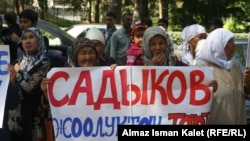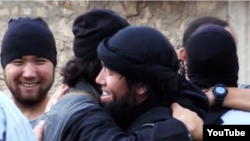
Once again, Qishloq Ovozi is pleased to feature the work of another up-and-coming authority in the field of Central Asian studies. This article sees the return of Matt Kupfer to the Qishloq. Kupfer authored an earlier article on ethnic violence in Osh. This time the topic is the necessary, and unavoidable, role of Islam in society and education in Kyrgyzstan, and the need for understanding and tolerance.
In 2011, my friend Zulfiya graduated from high school in her hometown not far from Osh, Kyrgyzstan. It would have been an ordinary, if important, milestone for most young Kyrgyz people. But, for Zulfiya, it was a major victory. Why?
Zulfiya, who asked to hide her identity with a pseudonym, is a religious Muslim who wears the hijab, something that went against the dress code of her high school. As a result, the school administrators told her she would have to remove her headscarf to continue attending school. And, when she refused, they sent her home.
Zulfiya was not alone in her predicament. She estimates that fifteen of her classmates removed their headscarves and around twenty stopped attending school entirely.
But not Zulfiya. She persisted. The next day she came back to school in her hijab. And when they kicked her out again, she came back the next day, and the day after that. And she kept coming until the exasperated school administrators gave up and let her continue her studies.
"I think Allah himself supported me and gave me strength and hope," she recently told me. "I never gave up. I wanted with all my heart just to study and study."
One day, after being ejected from school, Zulfiya stood out in the schoolyard looking through the window at the students in class and thought about how lucky they were. At that moment, she promised herself that, God willing, she would become someone who would make all those who had opposed her recognize how wrong they were. Today, she is well on her way: Zulfiya was the only student in hijab to graduate from her high school. She now studies at a university in the north of Kyrgyzstan and hopes to become a diplomat.
Zulfiya's story fits into a wider narrative of tension surrounding the growth of Islam in post-Soviet Kyrgyzstan, one that continues to this day. The recent mobilization of protestors shouting: "This is a Muslim country" to prevent a concert by a gender-bending Ukrainian male dance troupe in Bishkek, the passage by the Kyrgyz parliament of a Russian-style "gay propaganda" law, and the rise of Islamic State (IS) in the Middle East and IS alarmism in Eurasia all raise an old, highly polarizing question: is Kyrgyzstan at risk of "Islamization?"
'Mixed' Identity
Unfortunately, if the recent history of this debate is any indicator, Muslims will advocate Islam and secularists will advocate secularism. Competing identities will be presented as exclusive, "Islamization" as the antithesis of democracy, and extremism as the potential end result of increased religiosity. Supporters of both sides will come away from the debate more convinced that they are correct and that there is little chance to find common ground with their opponents.
But, as Zulfiya's story shows, identities are hardly so black and white. Zulfiya is a religious Muslim woman who wears hijab, wants to have a secular career in government, and sees no conflict in this supposedly "mixed" identity. The biggest threat to her is neither Islam nor secularism, but the failure of the government to integrate all members of society and resolve the issue of hijab in public institutions.
At fault here is the government, but a government is made up of people, and the people are often equally polarized. Blogosphere responses to a 2007 decision by a government commission to allow women to wear hijab in passport photos often read like a list of young, educated progressives worried by the impending "Islamization."
And it got worse: in the wake of the 2010 interethnic rioting in Kyrgyzstan's diverse south, many ethnic Kyrgyz claimed (incorrectly) that the traditionally more religious ethnic Uzbeks were working with Islamic extremist groups like the Islamic Movement of Uzbekistan.
Visitors to Kyrgyzstan often encounter the religion issue in conversations with locals. In 2010, a Kyrgyz acquaintance in Bishkek pointed out two women in headscarves walking down the street and announced, "This is not our culture." In 2013, an Uzbek friend in Osh lamented the amount of private local and foreign funding going into building mosques in the city, when the state could hardly afford to build new schools and hospitals. "I'm a Muslim, too," he sighed, "but I'm a normal Muslim."
In February of this year, President Almazbek Atambaev lambasted the growing role of Islam in politics and suggested that hijabs on young women represent a foreign import that erases traditional Kyrgyz culture. This month, he made similar statements about "radical Islamization," warning of the growth of Islam that is not in harmony with the Kyrgyz people's values. These comments likely scored points with many Kyrgyz citizens who remain suspicious of growing religiosity, but they also feed these same religious tensions the country has long faced.
In fact, if Kyrgyzstan is truly concerned about Islamic extremism, it should fear religious polarization more than Islam. Polarization alienates religious Muslims and creates conditions conducive to discrimination, which can lead Muslims to turn toward more extreme forms of Islam. But efforts to better integrate religious Muslim citizens and respect their views will give them a bigger stake in the future of Kyrgyzstan.
Bridging The Gap
When I first learned about Zulfiya's story last year, I tweeted about it and commented, "It always surprises me when people consider bans on religious clothing to be democratic. Democracy is when you defend the rights of those with whom you disagree." Kyrgyz parliamentarian Tursunbai Bakir uulu quickly retweeted it and commented in support, "A reasonable remark!"
Bakir uulu and I make strange bedfellows. I'm a secular Jew from America and a liberal. He's a religious Muslim conservative known for his harsh rhetoric against Western influence, the LGBT (lesbian, gay, bisexual, transgender) community, and Israel. We probably agree on virtually nothing, but found common ground on a woman's right to wear hijab in school.
Religion will likely remain a tense topic in Kyrgyzstan, as it can be in many countries. But, to improve the situation, more of Kyrgyzstan's own local "strange bedfellows" need to come forward. That means secularists willing to reach across the aisle to support the basic rights of religious Muslims to practice their faith and express their identity as they choose and religious Muslims who recognize the need for open discourse with secularists.
Many may fear "Islamization," but interest in Islam is already growing and won't likely stop any time soon. Would nearly twenty of Zulfiya's classmates who dropped out of school because of their hijabs truly be more "dangerous" to Kyrgyzstan with a secular education and the social and economic opportunities it provides?
In fact, it's probably the opposite: breaking free from the polarized discourse over Islam and better integrating religious Muslims would also help protect the rights of Kyrgyzstan's more secular citizens. A Muslim community that feels its rights are supported by the secular majority and wants to preserve that support will be more willing to compromise and respect the views of secular citizens.
But, first, both secular and religious citizens of Kyrgyzstan concerned about the future of their country will have to come forward, ready and willing to bridge the gap and forge a better discourse.
-- Matt Kupfer







